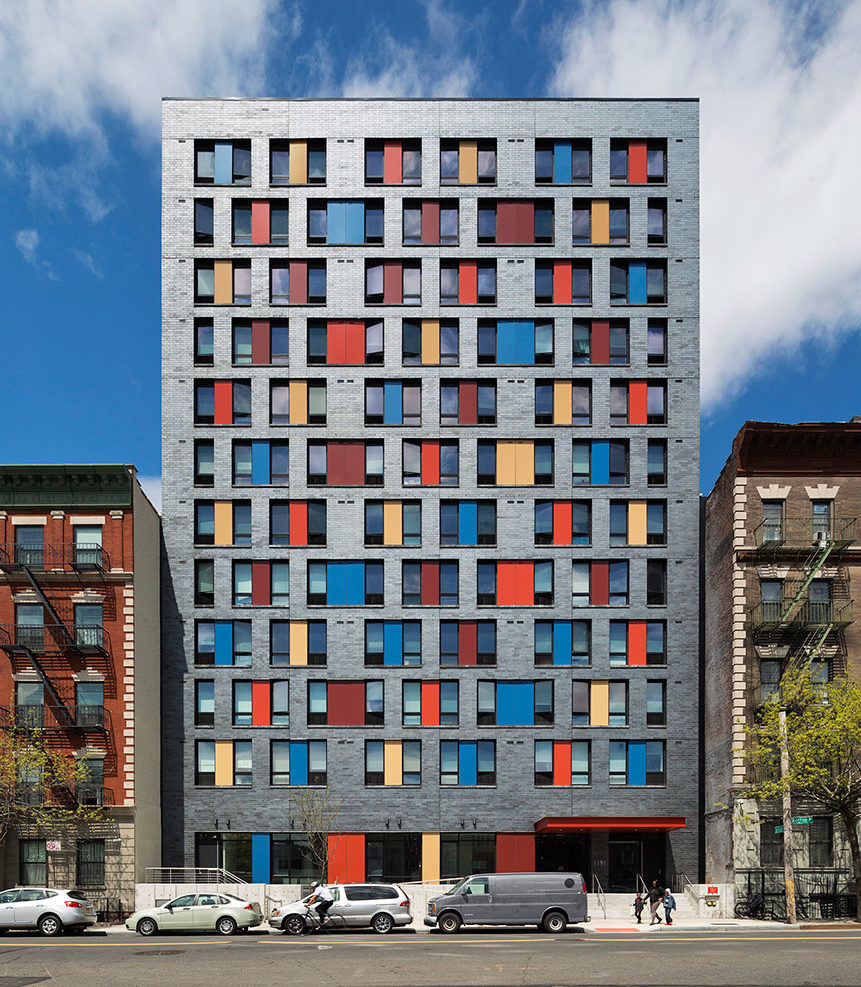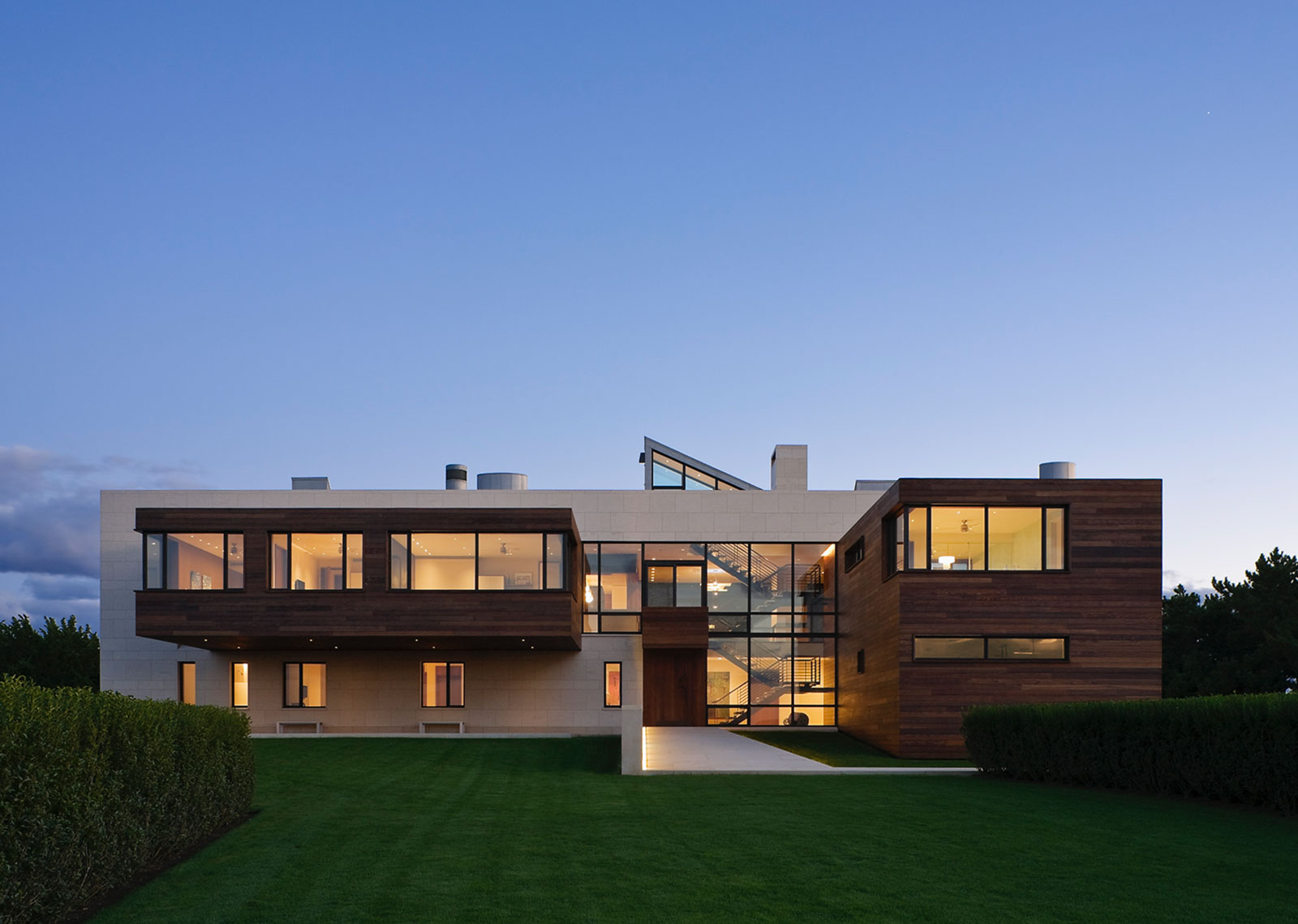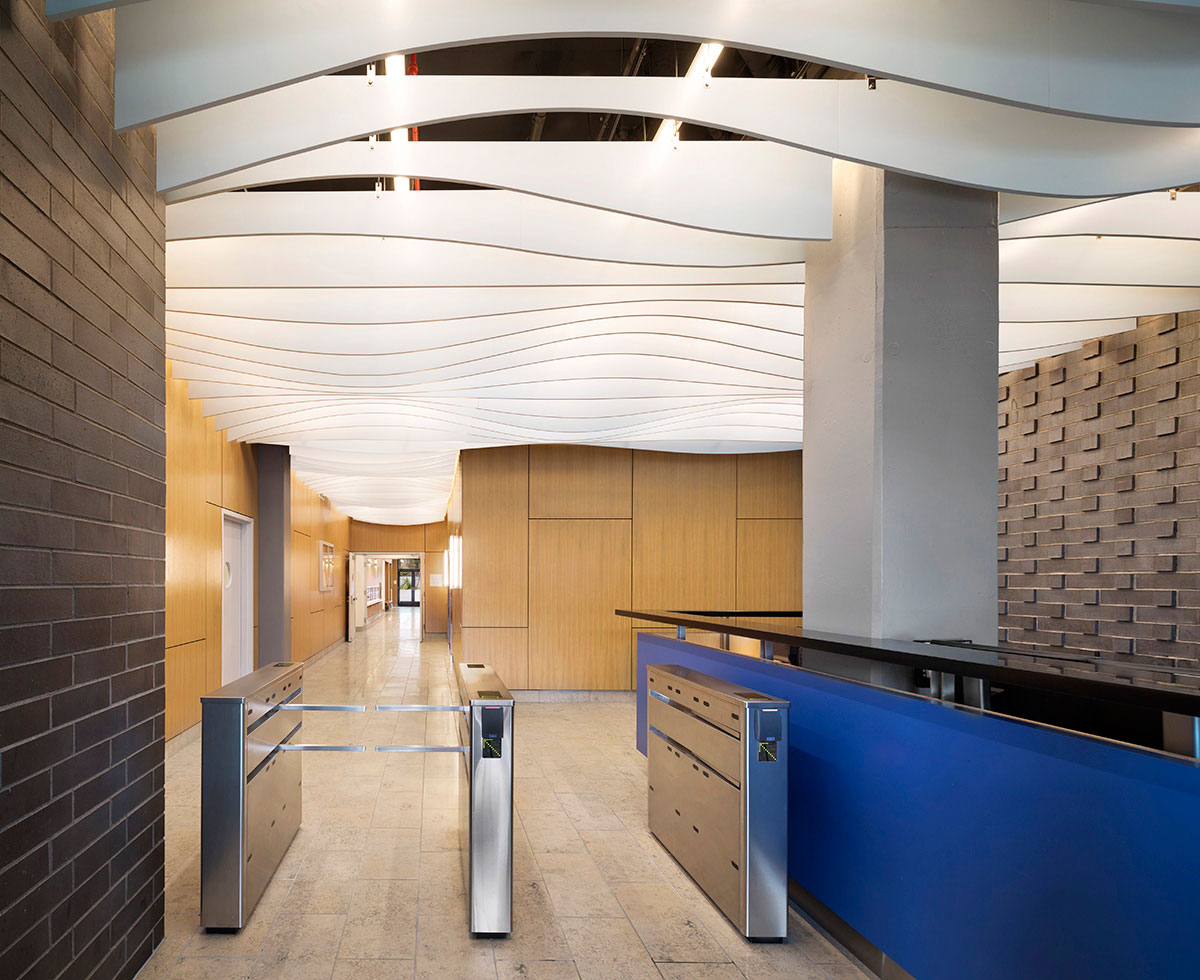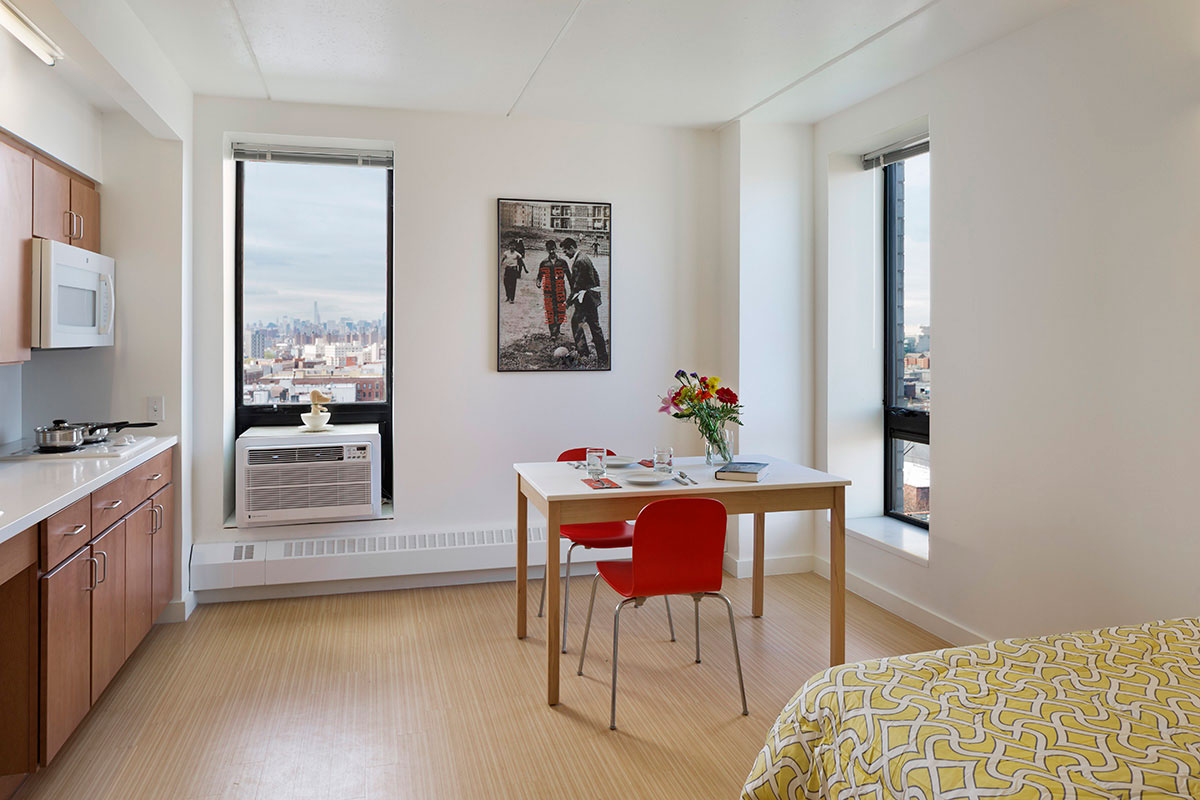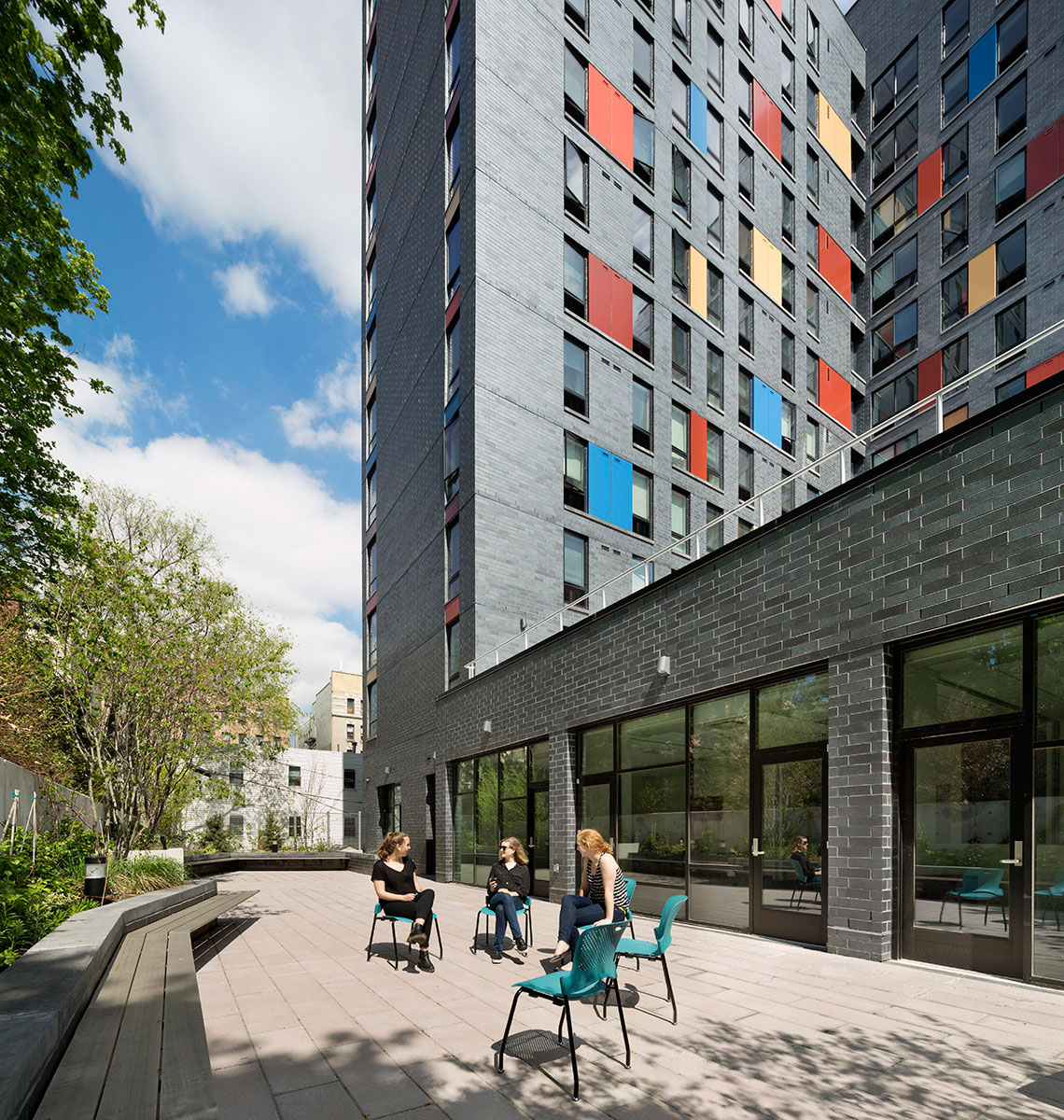The finest apartment building completed recently in New York City is in several respects far from the super-tall, super-thin aeries of Billionaires’ Row around 57th Street and the avant-garde condos crowding the High Line in Chelsea. Designed by the architect Alexander Gorlin, it is a twelve-story, 154-unit structure in the gritty Morrisania section of the South Bronx. Called Boston Road Supportive Housing—after its address on the old Boston Post Road—this crisp, colorful scheme fairly jumps out of its drab surroundings.
Boston Road’s strikingly fresh, deceptively simple, but carefully composed façade mixes and mashes bright metal panels in syncopated rhythms that make you wonder why so many buildings have to be so boring. It engages your eye in much the same way that a catchy pop tune gets into your head and refuses to budge. Most conspicuously, it differs from those new Manhattan towers in being conceived not for society’s most privileged members but the least, namely once-homeless people who are aged, survivors of HIV/AIDS, and among the working poor.
The most visible of the new Manhattan redoubts for the global plutocracy—Rafael Viñoly’s 85-story 432 Park Avenue—can be seen from Boston Road’s upper floors. Yet although these two buildings were built with vastly different budgets, the notable contrast in design quality between Viñoly’s magic beanstalk and Gorlin’s pragmatic gem proves that America’s ever-widening gap between rich and poor is neither inevitable nor unbridgeable when it comes to architecture.
Still, beauty is as beauty does, and the strong social underpinnings of Boston Road give it a significance beyond mere good looks. Gorlin knows both sides of this equation better than most of his fellow professionals. On the one hand, he does a thriving business in clean-lined, exquisitely detailed modernist houses and interiors for billionaires, as well as aesthetically ambitious synagogues for wealthy congregations in well-off New York suburbs such as Chappaqua, Kings Point, and Plainview. (His mystically inspired approach incorporates Jewish symbolism more esoteric than the usual menorah or burning bush, and is the subject of his 2013 book Kabbalah in Art and Architecture.)
On the other hand, Gorlin feels a moral obligation to do less remunerative but more socially beneficial work, and subsidizes the time he spends on such undertakings with the proceeds from his lucrative luxury commissions, like an architectural Robin Hood. A substantial part of his practice is now devoted to collaborations with Breaking Ground—a private organization founded (as Common Ground) in 1990 to help alleviate homelessness with housing that reintegrates residents into the community through social service support rather than simply sheltering them. This initiative is a particularly vital contribution now that new publicly financed dwellings in this country are a thing of the past.
Boston Road is the latest of Breaking Ground’s projects around the city, which number about 3,500 units. Some of them are in converted hotels or apartment houses, but several are start-from-scratch, like this and the Brook, an earlier work by Gorlin in the Mott Haven section of the South Bronx. Because Breaking Ground believes in engaging first-rate talent no less so than today’s high-end condo developers (who seek name-brand designers as a marketing tool more than for urban betterment), the group offers an alternative for architects to apply their talents to a loftier purpose.
The quality of design that Gorlin has achieved here on a very limited construction budget of $30 million is extraordinary by any standard. Boston Road’s most arresting physical aspect is its handsome exterior. Unlike almost all other mid-block buildings in big cities—which have unfinished-looking sides and backs—each elevation of Gorlin’s L-shaped configuration is as fully surfaced and detailed as the lively main street façade. This is quite an achievement if one considers that the project cost about $325 per square foot, approximately half what luxury New York condos run these days.
Boston Road is clad in dark gray brick, a perfect foil for the primary and secondary hues Gorlin chose for metal panels between the windows. The exterior brings to mind several historical precedents. For example, the Weimar German architect Bruno Taut often had his low-cost housing settlements painted in bright colors to give them greater gaiety and variety. The most direct chromatic antecedent for Boston Road is Le Corbusier’s Unité d’Habitation of 1947-1952 in Marseilles, with the deep reveals of its gridded concrete elevations finished in red, yellow, or blue. Corbusier’s younger Catalan contemporary Josep Lluís Sert used similar rectangles of primary colors to enliven the façades of his buildings. The outer wall treatments at Boston Road recall these precursors, but like the best artistic appropriations Gorlin takes a good idea and makes it better.
Advertisement
The interiors of Boston Road are equally successful, beginning with an entry sequence that shows how much can be achieved with very little. The wall behind the sleek security desk is made from matte-black painted brick in a rhythmic bas relief. The ceiling of the corridor that leads from there to residents’ elevators is hung with rows of pale-blue painted plywood baffles in variously curved profiles and a wavelike pattern that almost seems to ripple as you pass beneath. Very few hip boutique hotels have lobbies as stylish (or inexpensive) as this.
The corridors are paneled with honey-toned oak veneers (cut thin enough to make them economical), and the apartments themselves—all one-room studios with a private, windowless bath—seem the equals of new offerings on the thriftier end of the so-called luxury market. The residents of Gorlin’s building will occupy 350-square-foot units that are virtually indistinguishable from the new “micro-apartments” that have begun appearing in New York in response to skyrocketing real estate values. At one of them, Carmel Place on East 27th Street, a 360-square-foot studio rents for $2,920 a month, as opposed to an average of $550 here (where fees are gauged on ability to pay).
At Boston Road kitchen appliances occupy one long wall of the rectangular single-occupancy spaces, which include a microwave oven and air conditioning. But given the current fashion for loft-like open-plan layouts in even the costliest new construction, refrigerators and sinks in living areas hardly feel jarring.
In addition to Boston Road’s shared amenities—which include an exercise room with fitness machines on a par with commercial gyms, a bike room, a computer center, and a laundry room—the facility contains ample common areas for its full roster of social services. Among them are a resident nurse, a twelve-step program, nutritional and weight-loss guidance, career counseling, and discussion groups, all aimed at propelling residents into self-sufficient lives in the larger community. As other Breaking Ground facilities have demonstrated, these all-important support and monitoring activities can prevent recidivism to a remarkable degree.
Boston Road’s model of a mixed population of former vagrants alongside low-income workers is an important step forward in destigmatizing homelessness, and the proximity of employed residents with others just off the streets provides a potentially motivating example of self-help. Sixty of the Boston Road apartments are earmarked as affordable for the working poor, with preference given to people from the surrounding neighborhood, more than nine hundred of whom applied and were chosen by lottery. The remaining ninety-four supportive units were allocated to the homeless, who were referred by city welfare agencies.
Though it has recently reached crisis proportions, homelessness in New York City seems to attract widespread concern only during the bitterest stretches of winter, when large numbers seek emergency shelter in the nether reaches of Penn Station, the Port Authority Terminal, and other indoor public spaces. But if the financial capital of the world’s richest nation shows little evidence that it will eradicate this age-old condition anytime soon, then Alexander Gorlin’s admirable effort at Boston Road provides an encouraging template for how we can begin to exit from this collective shame.


